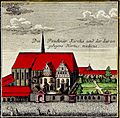Gloria in excelsis Deo, BWV 191 facts for kids
Quick facts for kids Gloria in excelsis Deo |
|
|---|---|
| Church cantata | |

Paulinerkirche, Leipzig, 1740s
|
|
| Related | Gloria of Missa, BWV 232 I (early version) |
| Occasion | Christmas |
| Text | Gloria, Doxology |
| Performed | 25 December 1742: Paulinerkirche, Leipzig |
| Movements | 3 |
| Vocal | |
| Instrumental | |
Gloria in excelsis Deo (which means "Glory to God in the Highest" in Latin), also known as BWV 191, is a special piece of music called a church cantata. It was written by the famous German composer Johann Sebastian Bach. This cantata is unique because it's the only one of Bach's church cantatas that uses a Latin text instead of German.
Bach likely wrote this Christmas cantata in Leipzig around 1742. It was probably performed for a special celebration at the University of Leipzig. All three parts, or "movements," of this cantata come from an earlier piece Bach wrote in 1733. That earlier piece was a "Kyrie–Gloria Mass" for the Dresden court, which Bach later used as the "Gloria" section of his very famous Mass in B minor.
History of the Cantata
The cantata Gloria in excelsis Deo was created for Christmas Day. Bach himself wrote on the original music sheet, "J.J. Festo Nativit: Xsti." This means "Celebration for the birth of Christ." It was meant to be sung during a church service, usually around the time of the sermon.
For a long time, people thought this cantata was first performed in 1743 or 1745. However, new information from old records and music papers suggests it was most likely performed in 1742. This performance would have been for a regular Christmas celebration by the University of Leipzig. It took place at the Paulinerkirche, a church in Leipzig.
Most of Bach's other church cantatas use German words. These words often come from the Bible, hymns, or poems of the time. But this cantata is different because its words are in Latin. They are taken from the traditional Christian texts known as the Gloria and the Doxology. This makes BWV 191 the only Latin cantata among about 200 of Bach's sacred cantatas that have survived.
This cantata is based on music Bach wrote earlier in 1733. That 1733 piece later became the first part of his huge and important work, the Mass in B minor. The first movement of BWV 191, called "Gloria," is almost exactly the same as the first two movements of the "Gloria" section from his earlier 1733 work. The second and third movements of BWV 191 are also very similar to other parts of the 1733 "Gloria." Bach made some small changes, for example, moving some parts from being sung only by voices to being played with instruments.
Music and Structure
Bach himself wrote a note on the cantata's music sheet. It says the cantata is for "5 Voices, 3 Trumpets, Timpani, 2 Flutes, 2 Oboes, 2 Violins, Viola, and Continuo." This shows it was written for a grand and festive sound.
The cantata features soprano and tenor solo singers. It also has a choir with an unusual five parts, including two soprano parts. The instruments include three trumpets, timpani (kettledrums), two flauto traverso (a type of flute), two oboes, two violins, a viola, and a basso continuo (a group of instruments that play the bass line and harmonies).
The only part of the cantata directly linked to Christmas is the opening chorus. It uses words from the Book of Luke (Luke 2:14) in the Bible. This part was performed before the sermon in the church service.
The other two movements were performed after the sermon. They use general words from the Doxology, which is a hymn of praise.
- The second movement is a duet for soprano and tenor. It's called Gloria Patri et Filio et Spiritui sancto ("Glory to the Father and to the Son and to the Holy Spirit"). This part is similar to the "Domine Deus" section in the "Gloria" of the Mass in B minor.
- The third and final movement is a chorus called Sicut erat in principio ("As it was in the beginning"). This part is similar to the "Cum sancto spiritu" section of the "Gloria" in the Mass in B minor.
Sometimes, the final movement might have extra instruments playing along with the choir. This is similar to how Bach used extra instruments in another Christmas cantata, [Unser Mund sei voll Lachens, BWV 110] Error: {{Lang}}: text has italic markup (help).
Here are the three movements of the cantata:
- Coro (Chorus): Gloria in excelsis Deo
- Duetto (Duet for soprano and tenor): Gloria Patri et Filio et Spiritui sancto
- Coro (Chorus): Sicut erat in principio
Images for kids
See also



